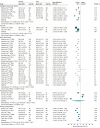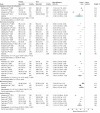Academic Outcomes of School-Aged Children Born Preterm: A Systematic Review and Meta-analysis
- PMID: 32242904
- PMCID: PMC7125435
- DOI: 10.1001/jamanetworkopen.2020.2027
Academic Outcomes of School-Aged Children Born Preterm: A Systematic Review and Meta-analysis
Abstract
Importance: Children born preterm are at an elevated risk of academic underachievement. However, the extent to which performance across domain-specific subskills in reading and mathematics is associated with preterm birth remains unclear.
Objective: To conduct a systematic review and meta-analysis of academic outcomes of school-aged children born preterm, compared with children born at term, appraising evidence for higher- and lower-order subskills in reading and mathematics.
Data sources: PubMed/MEDLINE, PsycINFO, and the Cumulative Index of Nursing and Allied Health Literature electronic databases from January 1, 1980, to July 30, 2018, were searched for population, exposure, and outcome terms such as child (population), preterm birth (exposure), and education* (outcome).
Study selection: Peer-reviewed English-language publications that included preterm-born children and a comparison group of term-born children aged 5 to 18 years and born during or after 1980 and that reported outcomes on standardized assessments from cohort or cross-sectional studies were screened. Of the 9833 articles screened, 33 unique studies met the inclusion criteria.
Data extraction and synthesis: Data were analyzed from August 1 to September 29, 2018. The Preferred Reporting Items for Systematic Reviews and Meta-analyses (PRISMA) guidelines were followed. Two reviewers independently screened the databases and extracted sample characteristics and outcomes scores. Pooled mean differences (MDs) were analyzed using random-effects models.
Main outcomes and measures: Performance on standardized assessment of higher-order subskills of reading comprehension and applied mathematics problems; lower-order reading subskills of decoding, pseudoword decoding, and word identification; and lower-order mathematics subskills of knowledge, calculation, and fluency.
Results: Outcomes data were extracted for 4006 preterm and 3317 term-born children, totaling 7323 participants from 33 unique studies. Relative to children born at term, children born preterm scored significantly lower in reading comprehension (mean difference [MD], -7.96; 95% CI, -12.15 to -3.76; I2 = 81%) and applied mathematical problems (MD, -11.41; 95% CI, -17.57 to -5.26; I2 = 91%) assessments. Across the assessments of lower-order skills, children born preterm scored significantly lower than their term-born peers in calculation (MD, -10.57; 95% CI, -15.62 to -5.52; I2 = 92%), decoding (MD, -10.18; 95% CI, -16.83 to -3.53; I2 = 71%), mathematical knowledge (MD, -9.88; 95% CI, -11.68 to -8.08; I2 = 62%), word identification (MD, -7.44; 95% CI, -9.08 to -5.80; I2 = 69%), and mathematical fluency (MD, -6.89; 95% CI, -13.54 to -0.23; I2 = 72%). The associations remained unchanged after sensitivity analyses for reducing heterogeneity.
Conclusions and relevance: These findings provide evidence that preterm birth is associated with academic underperformance in aggregate measures of reading and mathematics, as well as a variety of related subskills.
Conflict of interest statement
Figures
References
Publication types
MeSH terms
LinkOut - more resources
Full Text Sources
Medical
Research Materials
Miscellaneous



